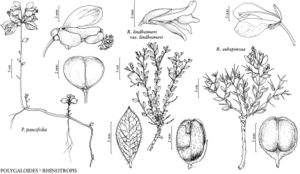Difference between revisions of "Rhinotropis subspinosa"
J. Bot. Res. Inst. Texas 5: 135. 2011.
imported>Volume Importer |
GeoffLevin (talk | contribs) m (Edited basionym to match printed version) |
||
| (One intermediate revision by one other user not shown) | |||
| Line 9: | Line 9: | ||
|common_names=Spiny or cushion or showy milkwort | |common_names=Spiny or cushion or showy milkwort | ||
|basionyms={{Treatment/ID/Basionym | |basionyms={{Treatment/ID/Basionym | ||
| − | |name= | + | |name=Polygala subspinosa |
| − | |authority=Watson | + | |authority=S. Watson |
|rank=species | |rank=species | ||
|publication_title=Amer. Naturalist | |publication_title=Amer. Naturalist | ||
| Line 42: | Line 42: | ||
|parent rank=genus | |parent rank=genus | ||
|synonyms= | |synonyms= | ||
| − | |basionyms= | + | |basionyms=Polygala subspinosa |
|family=Polygalaceae | |family=Polygalaceae | ||
|phenology=Flowering spring–mid summer. | |phenology=Flowering spring–mid summer. | ||
| Line 52: | Line 52: | ||
|publication year=2011 | |publication year=2011 | ||
|special status= | |special status= | ||
| − | |source xml=https://xjsachs2@bitbucket.org/aafc-mbb/fna-data-curation.git/src/ | + | |source xml=https://xjsachs2@bitbucket.org/aafc-mbb/fna-data-curation.git/src/e39f0e846f172941159b2045254d62d10d9823f6/coarse_grained_fna_xml/V10/V10_514.xml |
|genus=Rhinotropis | |genus=Rhinotropis | ||
|species=Rhinotropis subspinosa | |species=Rhinotropis subspinosa | ||
Latest revision as of 19:41, 9 December 2022
Subshrubs or shrubs, multi-stemmed, 0.5–2.5(–6) dm. Stems prostrate to erect, sometimes glaucous, at least when young, glabrous or pubescent, hairs spreading to slightly incurved. Leaves subsessile to petiolate, petiole to 1(–2) mm; blade obovate or elliptic, 4–31 × 0.8–11 mm, base cuneate, apex rounded or acute, surfaces densely to sparsely pubescent or subglabrous, hairs spreading to slightly incurved. Racemes terminal, sometimes reduced to (1 or)2–few flowers, 3–12.5 cm; rachis thorn-tipped; peduncle 0.1–0.5 cm; bracts usually deciduous, rarely persistent, elliptic, ovate, or lanceolate. Pedicels (1.5–)3.5–10(–20.5) mm, glabrous or pubescent. Flowers pink to rose, wings (and other sepals) sometimes light green, distal keel yellow or green, (6–)8–12(–13) mm; sepals deciduous, ovate, elliptic, or lanceolate, 2–7.2 mm, glabrous or pubescent; wings obovate to elliptic-obovate, (5–)7–11.5(–12.2) × (2.3–)3–5.2(–5.9) mm, glabrous or pubescent; keel (5.4–)6.2–10.5 mm, sac glabrous, beak oblong, 1–3 × 0.9–1.5 mm, glabrous. Capsules ellipsoid to obovoid, 4.3–8.8(–10) × 3.7–7.3 mm, base cuneate to rounded, margins with narrow, entire or slightly erose wing, glabrous or pubescent. Seeds 3.3–4.9 mm, ± evenly and moderately densely pubescent, occasionally with glabrate patches; aril 1.2–3.1 mm, lobes to 1/2 length of seed. 2n = 18, 36.
Phenology: Flowering spring–mid summer.
Habitat: Gravelly soils derived from limestone, shale, lava, or tuff, or crevices of soft calcareous rocks on eroded hills, open slopes and flats, in desert scrub, open pinyon-juniper woodlands, mountain brush, ponderosa pine woodlands.
Elevation: 1300–2400 m.
Distribution
Ariz., Calif., Colo., Nev., N.Mex., Utah.
Discussion
Selected References
None.
